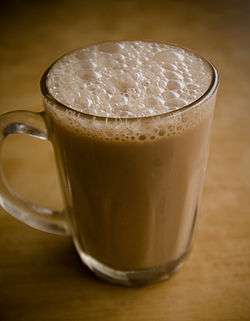Teh tarik
 | |
| Type | Beverage |
|---|---|
| Place of origin | Malaysia [1] |
| Region or state | Malaysia, Singapore, Indonesia, Thailand and Brunei |
| Created by | Indian-Muslim immigrants in Malay Peninsula[1][2] |
| Serving temperature | Hot, Cold |
Teh tarik (literally "pulled tea") is a hot milk tea beverage which can be commonly found in restaurants, outdoor stalls and kopi tiams within the Southeast Asian countries of Brunei, Malaysia and Singapore.[1] Its name is derived from the pouring process of "pulling" the drink during preparation. It is made from a strong brew of black tea blended with condensed milk. Malaysia has considered the drink as the country's national drink.[3]
Origin
The origins of teh tarik can be traced to Indian-Muslim immigrants in the Malay Peninsula who set up drink stalls at the entrance of rubber plantations after World War II to serve the workers there.[1] Since colonial times, teh tarik has been a popular Malaysian Indian cuisine for many in British Malaya and Singapore. Traditionally, teh tarik has been seen served with the Roti canai which has become a popular breakfast set by Malaysians until today.
An element of showmanship exists in the preparation of teh tarik. The ability to drag a long stream of tea above the heads of the patrons without giving them a shower is an amusing novelty for the locals and tourists alike. In Malaysia, there are occasions where teh tarik brewers gather for competitions and performances to show their skills. Teh tarik has become recognised along with nasi lemak as part of the food and beverage heritage of Malaysia by the Malaysian government ministry.
Preparation
The mixture is poured back and forth repeatedly between two vessels from a height, giving it a thick frothy top. This process cools the tea to optimal drinking temperatures, thoroughly mixes the tea with the condensed milk, and improves its flavour. This is often compared to the decantering of toddy to enhance its flavour.
Locally and regionally sourced tea used for teh tarik are not of the highest grade. Despite the strong aroma from the common Ceylonese variety, the taste is rather acrid and generally would not go well with a little cream or fresh milk like other fine tea. Hence condensed milk is used to balance any overpowering taste with its creamy and sweet flavour.
The term kurang manis, which can be translated to "less sweet", is a common request for those who are health conscious or not fond of sugary drinks, as teh tarik is typically prepared on the sweet side to taste by most vendors.
Variations
- Teh Ais, also known as Teh Tarik Ping, refers to tea sweetened with condensed milk (with or without the tarik treatment) that is simply served in a glass with ice cubes.
- Teh Tarik Madu refers to teh tarik blended with honey as part of its preparation, which is usually served cold.
- Teh Halia, teh tarik flavoured with ginger.
- Teh Madras, a variant popular in Sabah and Labuan, is made with frothed milky tea layered on top of hot milk.
- Teh-C refers to tea made with unsweetened evaporated milk, unlike the traditional teh tarik which is made with sweetened condensed milk. Vendors however will add sugar to Teh-C unless specifically asked not to. The Malay word for nil or zero, kosong, is used to indicate that the drinker does not want their beverage to be sweetened. The ‘C’ stands for ‘Carnation’, a popular brand of evaporated milk.
- Teh-O refers to black tea without any addition of dairy products or creamers entirely, hence the ‘O’ stands for "original". Like Teh-C, sugar is usually added except when Teh-O kosong is specified, where once again sugar is omitted.
- Kopi Tarik is local coffee, dark roasted with margarine and sugar, which is sweetened with condensed milk and pulled to froth it up. Drinks made with Milo and Nescafe may also be served with the tarik treatment by vendors which specialise in teh tarik.
See also
References
| Wikimedia Commons has media related to Teh tarik. |
- 1 2 3 4 Bonny Tan (2013). "Teh tarik". National Library Board. Retrieved 30 August 2016.
- ↑ Su-Lyn Tan (2003). Malaysia & Singapore. Lonely Planet. pp. 158–. ISBN 978-1-74059-370-0.
- ↑ "Lipton urges Malaysians to take pride in teh tarik, our national beverage". New Sabah Times. 7 September 2012. Archived from the original on 2 July 2014. Retrieved 6 November 2013.